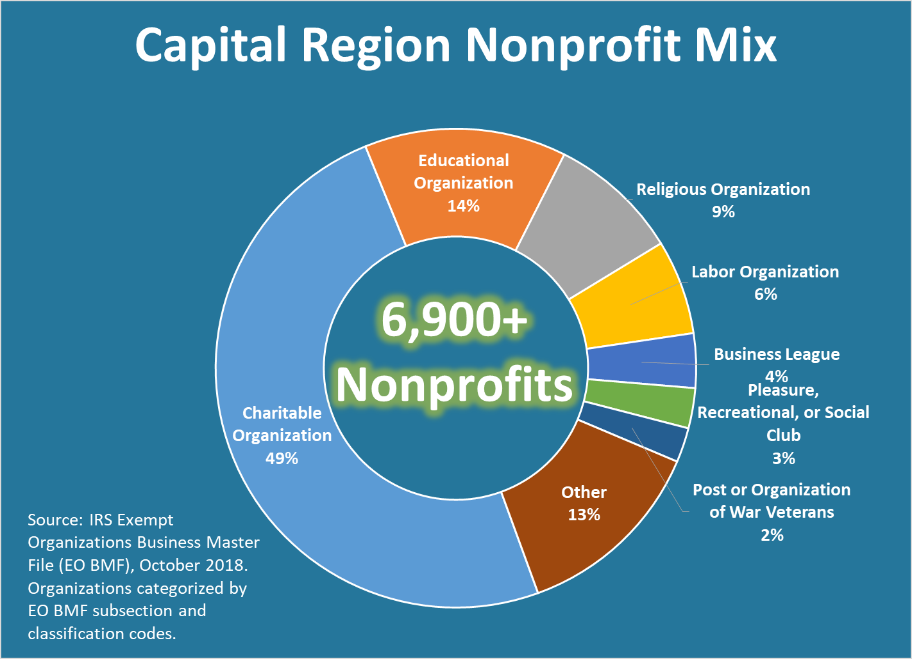Economic Impacts of Capital Region Nonprofits
Nonprofit organizations are playing an important role in supporting the Capital Region’s economic growth. In forming the backbone of the region’s creative economy, training the workforce and providing an abundance of outdoor recreational opportunities, they are helping the Center for Economic Growth (a nonprofit) and the Capital Region Economic Development Council (CREDC) advance New York State’s priorities of placemaking, workforce, tradeable sectors and innovation.
To better understand the size and impact of the Capital Region’s nonprofit community, CEG reviewed the IRS’s Exempt Organizations Business Master File and found more than 6,900 organizations listed. Below are some key findings from CEG’s analysis.
Nonprofit Mix
Charitable Organizations: 3,443 organization (57 percent) – the region’s largest subsection.1
Education Organizations: 948 organizations (16 percent) – second-largest subsection.2
Creative Economy Organizations: 452 nonprofits classified as arts, culture and humanities3 and an additional 107 as cultural, historical of other educational activities4.
Youth Activities/Development Organizations: 125 organizations5.
Environmental Quality, Protection and Beautification Organizations: 141 organizations6.
Science, Medical and Technology Research Institutes, Services Organizations: 63 organizations7.

Financial Impact
Not all nonprofits have to report the revenues to the IRS. Churches and other religious organizations, for example, are not required to file 990 forms with revenue data. Among the more than 4,600 that last filed returns for tax periods ending in 2017 or 2018 (through August), more than 3,700 actually reported revenues. Here’s a closer look at the organizations’ reported revenues:
The 4,096 nonprofits that last filed returns ending in 2017 reported $8.7 billion in revenues. The additional 545 nonprofits that last filed returned for tax periods ending in 2018, through August, reported $776.8 million in revenues.
2017 CREDC-Funded Nonprofit Projects
Below is a select list of nonprofit projects that received funding through the state’s Regional Economic Development Council (REDC) in 2017.
Projects
Applicant, county (award): project title.
- Albany Barn, Schenectady ($85,000): Maker Space at Hillside View.
- Basilica Arts Inc., Columbia ($45,000): Administrative Workforce Expansion
- Capital District Women’s Employment Resource Center, Albany ($18,000): Capital District WERCforce Computer Call Center Training.
- Erie Canalway Heritage Fund, Albany ($150,000): Matton Shipyard Preservation Adaptive Reuse
- Hubbard Hall Projects, Washington ($63,200): Workforce Training and Development Expansion
- New York Folklore Society, Schenectady ($75,000): Workforce Training and Development Expansion
- Lake George Land Conservancy, Warren ($40,000): Pilot Knob Trail Reconstruction Project
- Palace Performing Arts Center, Albany ($2.5 million): Palace Theatre Renovation and Revitalization Project
- Albany Symphony, Albany, Columbia, Greene, Rensselaer, Saratoga, Warren, Washington ($75,000): River Sings New York Music Festival
- Capital Roots, Rensselaer ($75,000): The Urban Grow Center
- The Olana Partnership, Columbia ($420,000): Olana’s Historic Farm Landscape Restoration
CEG Activities
To support the Capital Region’s nonprofit community, CEG is engaged in the following activities:
Assisting the CREDC in identifying and supporting projects proposed by nonprofits and that would advance the Capital Region’s five-year economic development plan, Capital 20.20, as well as the state priorities of placemaking, workforce, tradeable sectors and innovation.
Working with the Upstate Alliance for the Creative Economy (ACE) last winter to conduct a dozen roundtables throughout the Capital Region to collect ideas on how to create more creative jobs and opportunities.
Collaborating with Onward to Opportunity, a veterans career skills program, to recruit to the Capital Region service members whose military careers are ending.
Serving as the administrator of nonprofit regional instructor organizations, such as the Chief Executives Network, a group for local manufacturing leaders.
Collaborating with nonprofits, such as the SUNY Research Foundation, Albany Medical Center and Rensselaer Polytechnic Institute, to spotlight the Capital Region’s R&D assets.
Notes
- 1 Organizations with an exempt organization subsection code of 03 and classification code of 1.
- 2 Organizations with an exempt organization subsection code of 03 and classification code of 2.
- 3 Organizations with a National Taxonomy of Exempt Code (NTEC) of A.
- 4 Organizations without an NTEC but with an activity code between 60 and 119.
- 5 Organizations with an NTEC of O or an Activity Code between 320 and 349.
- 6 Organizations with an NTEC of C or an Activity Code between 350 and 379.
- 7 Organizations with an NTEC of H or U or an Activity Code of 161 or 162 or between 180 and 199.
Don’t miss these insights into the trends that are shaping the Capital Region’s economy. Sign up for CEG’s e-news and follow us on:














